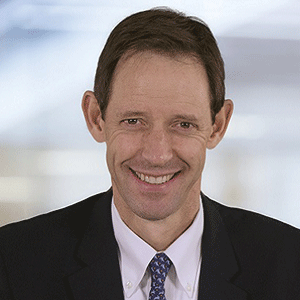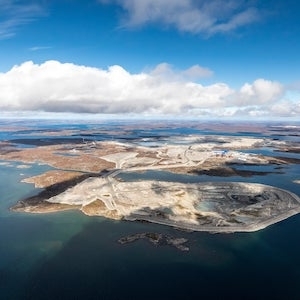
In two weeks, Bruce Cleaver (pictured) will step down as De Beers CEO, after six years in the role. His replacement will be energy executive Al Cook.
Going forward, Cleaver will serve as De Beers co-chair, along with Duncan Wanblad, the CEO of Anglo American, De Beers’ parent company.
Before Cleaver leaves the job of CEO, we wanted to talk with him about the highlights of his time running the company, and where he sees the industry going.
This is a two-part interview. The second part, which will run later this week, will cover a look back at Cleaver’s tenure. The first part, which runs today, concerns current events, including De Beers’ contract with Botswana, Russian sanctions, and what’s happening with Forevermark and Lightbox.
You’re leaving in two weeks. De Beers still does not have a new contract with Botswana. There’s been several extensions. Do you expect to have it done before you go?
No, I don’t expect it to be done before I go as chief executive, but it will certainly get done in my time as co-chairman. We’re all very committed on all sides to get it done by June [when the current extension expires], and I have no doubt we’ll get it done.
Will you still be involved in the negotiation or will your successor?
We’ve made this clear—and I think the government is pleased with this—that I will stay involved in finalizing the negotiations.
Regarding Forevermark, both [former Forevermark CEO] Stephen Lussier and [head of De Beers Brands North America] Charles Stanley have retired. People don’t necessarily know Stephen’s replacement, Marc Jacheet, and the person who is currently replacing Charles, Céline Assimon, is still new. The CEO of De Beers will be new, and he’s reporting to a CEO at Anglo American, who is also new. That’s caused a lot of uncertainty as far as the brand, especially given the new “one De Beers” strategy, and there were recently layoffs on top of that. Can you give me a sense of where Forevermark is going?
When there’s change, there’s always people who are slightly unsettled by it. Charles retired. He’s been with us a long time. He did a tremendous job for a long time.
Al has been very clear all along that he is not about revolution, but he’s about evolution. And I guess the fact that I’m staying on as chair would hopefully give people some comfort that we’re not going to see significant changes in the way the business thinks. I’m not expecting material changes in strategy. And the fact that Stephen remains involved in the Natural Diamond Council means he is still involved with De Beers, and of course [De Beers executive vice president of diamond trading] Paul Rowley is still very involved. I understand people are always unsettled at times of change, but these things do happen, and corporates carry on much longer than individuals. I’m not concerned about significant disruptive change coming up.
You also have a new CEO of Lightbox, Antoine Borde, who has more of a direct-to-consumer background than his predecessor. Do you see that business expanding?
Antoine will look at Lightbox and see whether it makes sense to expand it or not. It’s been a successful business. It’s continued to deliver against its original mandate, which is to help differentiate [lab-grown from natural diamonds].
The previous CEO, Steve Coe, was a production person. We got the production sorted out, and actually the production is tremendously well-done in Oregon, so he felt he’d come to the end. We found someone who has tremendous marketing expertise [as CEO]. It’s just kind of a natural evolution. Lightbox continues to do well within its own parameters. And if we think it’s appropriate to expand that, I guess we will. Again, it’s a decision for Antoine. But I wouldn’t expect a massive change of strategy there.
If we do scale it up, I assure you it’ll be on the same basis as we do it now. Obviously we’re much more focused on marketing natural diamonds, but we plan to allocate significant amounts of marketing revenue into Lightbox. Those are questions that we do think about, and they are legitimate questions, as we think about the future.
You have said you want to be an active co-chair. What exactly does that look like?
I’m going to work that out with Al, who has been in the building quite a lot: what’s the best thing for me to do to help him. I think what I will end up doing is spending a bit more time on external engagements. [Being De Beers CEO is] a very, very busy and complex role, and it’s hard to get out to all of the places that you would like to get to. I have not gone to as many trade fairs around the world. I always go to Vegas, but I haven’t gone to other [trade shows]. I haven’t gone as often as I might into some of the markets to spend time with the industry, to make sure I am an influential voice at the table.
I obviously will not be involved in anything executive, but as co-chair I’ll certainly still be involved in helping ensure that the strategy is still agreed by the board and is delivered by the team. We’ll work out what this involves as we go forward, but I do intend to keep in contact with the trade. And so hopefully, you’ll see a bit more of me going forward.
The diamond industry is known to be a relationship business. Do you think Al can carry on the current relatively good relations between De Beers and its clients?
As I mentioned before, I was very integrally involved in selecting Al. Given his background, he has the right kind of skills and the right manner and the right kind of humility to meet the clients and work well with them. And I’ve committed to the board that Paul and I will travel around the world with Al and make sure we introduce him to the clients. So you’re not going to see one of these transitions where the previous incumbent just disappears.
I’ll certainly make sure in my capacity as chairman that our clients around the world get to meet and spend time with [Al], and I’ve no doubt he will get on well. Paul has been in this game a long time and he has very good relationships with the customers.
There’s been a lot of talk that the U.S. government will want greater traceability as far as ensuring that no Russian-mined goods come into the United States. Will [tracking system] Tracr be able to help with that?
Tracr is now just about ready. About half our goods are on there. We will continue to talk about that through 2023. If there’s a significant step up in sanctions—and I know there’s talk about that, and I saw what you wrote—the question that we’re looking at now is how we do this even faster.
When we started talking about doing this four years ago, I don’t think we were particularly prescient—we just saw the need to be able to tell consumers a consistent story and try and do something better than anyone else. So we’ll have to step it up again. But we’re focused right now on getting as many goods as possible on Tracr.
Like all these new things, it hasn’t always been easy, but I think we’ve made tremendous progress in the last months.
When you talk to Al alone, what do tell him are the biggest challenges?
I prefer to look at them as opportunities. There are challenges, but I think we’ve got to be focused on driving consumer demand. We can never take our eye off that ball. We’re going to have to find ways of collaborating with others to do that on a generic level. I think from a branding point of view, I’m even more convinced than I was when we started this process that brands offer a tremendous opportunity.
Technology in the midstream is going to accelerate. We’ve got two or three really interesting things coming that I think will be significant steps forward.
I don’t worry about underlying demand for natural diamonds going away. I think people are still really invested in them. But there are many challenges out there that we need to deal with, as well as many opportunities.
In part 2, Cleaver discusses why De Beers’ decision to launch Lightbox was the “scariest thing” he’s ever done.
(Photo courtesy of De Beers)
- Subscribe to the JCK News Daily
- Subscribe to the JCK Special Report
- Follow JCK on Instagram: @jckmagazine
- Follow JCK on X: @jckmagazine
- Follow JCK on Facebook: @jckmagazine






